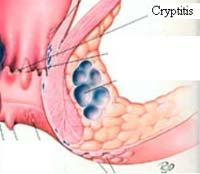How do anal crypts work?
Rectal crypts are tiny epithelial recesses at the upper end of the anal canal, at the mucosal junction. They are tiny lubricating mucus glands, arranged in a circle around the upper end of the anus. The crypts are located between physiological structures called anal papillae and are usually small, but sufficiently visible to give the ctenoid line a serrated appearance on rectoscopy.
They are small areas of skin located between the anal papillae. They are also called anal valves. They are about 3 mm deep and are lined with a layer of epithelium, which is the continuation of the anal skin, the squamous epithelium. Before defecation, the sphincter muscles contract and expel a drop of lubricating mucus from each of these crypts, contributing to the normal slippery exit of stool.
The anal crypts are normal structures that do not cause symptoms unless they become irritated.
How is cryptitis caused?
Cryptitis is defined as an inflammatory condition of the crypt, characterized by redness, swelling and thickening of the tissues in the area. This condition is identified with proctoscopy as a thick drop of pus oozing from the crypt at the level of the dentate line. Infection of the crypt often causes the ‘roof’ of the crypt to dissolve, causing anal fissure. A chronically infected crypt that does not re-form a “roof” can develop into an anal abscess and/or fistula.
Cryptitis is thought to be responsible for various conditions and symptoms. The pain caused by cryptitis is usually sharp or gives a burning sensation. A subtle pain or a sharp pain from spasm of the sphincter muscle may be the result of the inflammatory condition. The nature of the infection of the crypt is like an ebb and flow, so it may be so low level that the pain is transient.
The cause of cryptitis may be traced to the inflammatory condition in the adjacent areas, or to a disturbance in the acidic pH balance of the rectum. Injury from constipation stools, infections caused by external sources, parasites, foreign debris, etc., are some other reasons that may cause cryptitis.
Surgical removal of a crypt is not the complete answer to treating cryptitis. The cause must be eliminated first and foremost.

